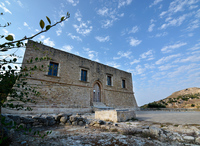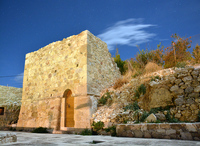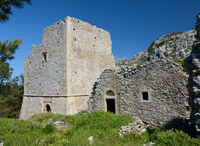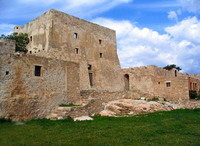Each historical era has left its sign in the soil of Sitia. During the declining years of the Minoan civilisation, the city of Presos continued to uphold Minoan values, successfully holding off Dorian invaders. It was finally destroyed by the powerful city of Ierapetra. The development of the Greek and Hellenistic period came to a halt with the arrival of the Romans who in turn left their mark - eg. the Roman fish tanks in Sitia and the theatre on the island of Koufonisi. The subsequent Byzantine period led to the construction of new fortresses, major ports and churches both large and small. Despite being easy prey for marauding pirates and robbers the Sitian people continued an uninterrupted cultural development of some significance.
The Venetians - new masters of the region - buried all previous history under the foundations of their new buildings, in this way stamping their authority on the area and leaving their own mark on the passage of time.
The Kazarma fortress, the feudal towers scattered around the area, imposing buildings and new settlements are all built on the ruins of the old. Wherever the visitor wanders, he can see traces of the long Venetian occupation in the "vigilae" and guard towers, in the spacious villas of the ruling families and in the fortifications.
The Ottoman Turks were the next people to leave their mark in the region. However, the Ottomans left few traces of cultural development. Their mark can be seen only in written archives and felt in the living traditions and stories which are etched into the collective memory of the peoples of Sitia and of the surrounding villages, many of which have names which can be traced back to the Ottoman occupation.
Kazarma
The castle fortress known today as "Kazarma" (Casa di arma), is the most imposing historical monument in Sitia.
The Kazarma used to be a military and administrative centre which consisted of a Medieval dwelling surrounded by walls. The fortification of the town and of the Kazarma can be dated to the late Byzantine period.
However, pirate raids, the continual uprisings against the Venetian occupation by the local people and the great earthquake all led to the partial destruction of the fortifications until the Venetians themselves were forced to completely destroy them with the intention of rebuilding them. This never happened and in 1651 the town was razed and then occupied by the Turks.
During the Turkish occupation it would appear that the walls were never rebuilt but the Kazarma was restored and evidence of the Turkish extensions can be seen today, for example in the cupolas ("koubedes") on the battlements that form the watch towers. The Kazarma has since been carefully restored and is open to the public offering a panoramic view across the bay of Sitia.
Concerts, plays, lectures and art exhibitions all take place in the Kazarma during the summer months as part of the festival known as "Kornaria".
Voila settlement
The deserted settlement of Voila occupies the north and west sides of the steep hill located on the eastern side of the Armenochantrades plateau. On the southeast side the settlement is protected by the steep cliff. In the north and western sides of the hill, the houses are built like fortifications, while a short wall is protecting the remaining perimeter towards the valley. The settlement spans below the contemporary road which destroyed many of the archaeological buildings when it was built. Domed warehouses or stables are still preserved in the low external zone while all the houses are built on the slope.
During the Venetian domination over the island, the settlement belonged to the feud of the Salomon family. During their reign they expanded the Aghios-Georgios church which also includes the family tomb of the Salomons. During the Ottoman Empire most of its citizens were ottomans and was also the base of a janizary battalion. The most know commander of the janizary was Jen Ali after whom the tower of the settlement was named. Since the end of the 19th century, the settlement declined and today lies in ruins. The majority of the remaining buildings belongs to the Ottoman Empire era. However, the architecture of the Venetian built edifices is a witnesse to the affluence of the area during their reign.
Etia Settlement
Etia probably took its name from the tree Itea (willow) The village seems to have been populated since the Byzantine period as one can see from the remaining churches of Aghios-Ioannis and Aghia-Ekaterini. During the Venetian reign it was on of the largest villages of the area with 563 citizens. The area was a feud of the Venetian aristocrat Dei Mezzo from the great Dei Mezzo family, which is one of the most populous families of Sitia. Dei Mezzo built the villa that bears its name and is one of the most important Venetian monuments of the Cretan country side.
The building had a rectangular shape with an entry hall covered by arches; as was the main dining hall and the corridor. All the auxiliary structures around the mansion were probably built during the Ottoman reign. Many engravings and the escutcheon of the Dei Mezzo family can also be found.
The villa was built at end of the 15th century, the same time the Toplou monastery was built and it was preserved intact until 1828. The building was surrounded by a big yard and was protected by walls. The main gate was palatial and bore the coat of arms of the Dei Mezzo family. On the eastern side of the yard close to the door, a fountain was found; the water was passed to the basin along the road.
Fortress of Liopetro
The fortress of Liopetra (from Leon di Pietra) which was built at the beginning of the 17th century AD, also belongs to the Hamezi area. In 579 the Venetian Proveditor Giacomo Foscarini had proposed to the Senate that such a fort should be built to shelter the inhabitants of Sitia in the event of war against the Turks.
The matter was brought up again by both Petros Zanos and Scotti in 1590 and 1595 respectively; so at the beginning of the 17th century the Senate gave orders for the building of this large fortress which could shelter as many as 6000 people.
There are indications that the fort was erected over the foundations of an ancient castle, the cistern of which remains still.
Monte Forte
Next to the village of Krya, there is a hill with the church of St. George and the ruins of a Venetian castle, called Monte Forte or Apano Κastelli, built during the 13th -14th century. The remains of the castle are preserved, along with a water tank. A cemetery of the pre-Minoan and Geometric period has been found in the area.







